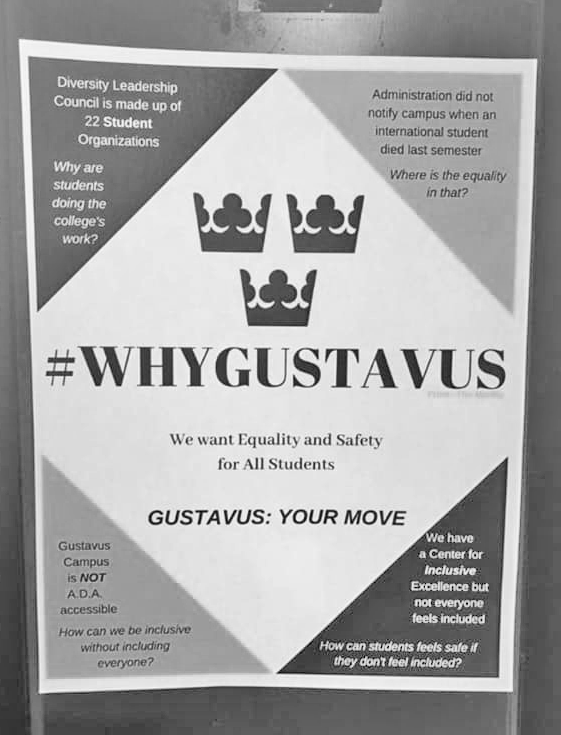During the past week, a poster was found in Beck with the quote, “How can we so freely advertise diversity…when we clearly don’t have enough?”.
This poster has caused an uproar of debate on campus as to just how diverse Gustavus really is.
The Gustavus student body is eighty percent white students as stated under the Enrollment section on the Gustavus website. This comparison to the national percentage of sixty percent white students.
Beyond just the apparent lack of diversity is the lack of support for the diverse students that we do have. A lack of proper financial aid, resources and meaningful representation cause the diverse students to feel less valued than their peers.
“As a racially diverse, socioeconomically diverse and neuro-diverse student” Senior Alli Orta said she feels that despite the increase of diversity in college in the last century it’s also about “how we can’t support the students of diversity that we do have.”
Gustavus estimates one academic year to be a total costs of around $57,400, meanwhile according to the United States Social Security Administration the national average yearly income is $52,145.80.
Many argue that the financial aid at Gustavus makes up for this staggering number; however, even if a student has the presidential scholarship, the maximum subsidized and unsubsidized FAFSA loans and works ten hours a week on campus they will still be left with a roughly $19,400 balance after the first year, based upon information available on the FAFSA website.To some, this may seem like a insignificant amount, but to a working class or lower-class student trying to make their way through college, this number is suffocating.
Even if a student makes it over the huge financial aid hurdle, they still have the arguably larger hurdle of making their way here at Gustavus. Gustavus highly values their alumni and their families, which seems like a great characteristic until you don’t fit in that category.
Gustavus values what they call “legacy” students to a degree that often overshadows nonlegacy students. Legacy students not only have the advantage of already having an understanding of Gustavus and an existing professional network on campus, but are also given perks such as the Legacy Scholarship. On the other side of this are the nonlegacy students and first-generation students who are given little to no help in navigating Gustavus and building a network for themselves in order to reach the same level of success.
I am a first-generation student, and when I ask why there aren’t certain resources or information readily available the answer I receive most is that the administration simply hadn’t thought about it before. Of course, these problems don’t occur to legacy students or students who aren’t first-generation students, but to first-generation and non-legacy students these problems make a huge impact on our lives at Gustavus.
Even past the cost and the lack of resources that make many minority students feel underacknowledged is the lack of meaningful representation of minority students.
When I say meaningful representation, I don’t mean photos in fliers or on the Gustavus website, but instead actually accurately representing what’s important to the minority groups on campus.
Arguably the largest and darkest example of this is the lack of acknowledgment of the death of a minority student in March of 2019. This student passed without a campus email or any announcement at all which starkly contrasts the responses to the recent deaths on campus.
Every student should get the same amount of respect, and their friends and family deserve the same chance to grieve that students from a majority group receive.
Diversity is more than just allowing people from minority groups to attend college here; it’s about acknowledging our differences, supporting them in the ways they need extra support, celebrating their accomplishments and representing them meaningfully in our dialogue on and about campus.
Every student on campus makes Gustavus what it is, and we all deserve an equal chance to success and representation.
